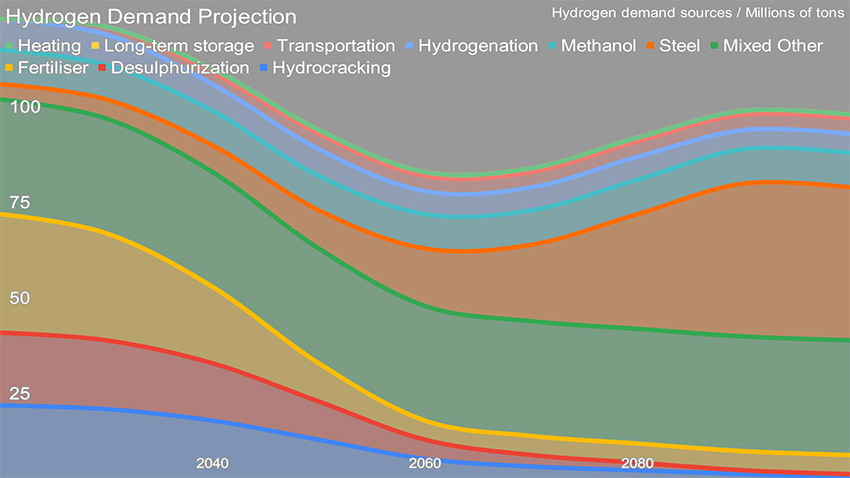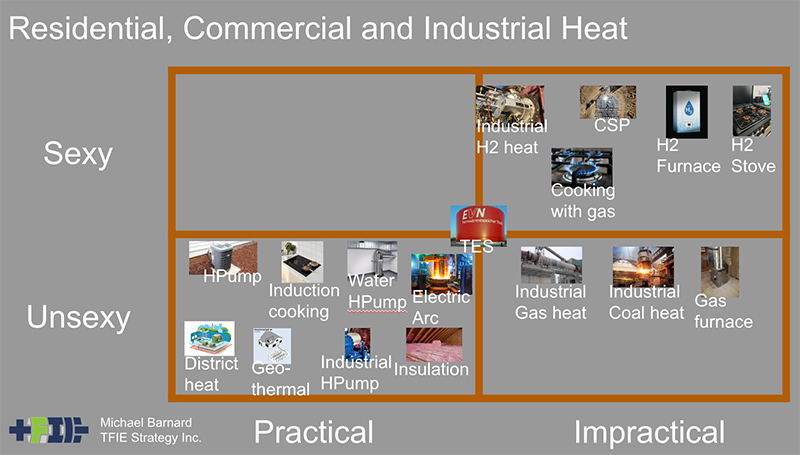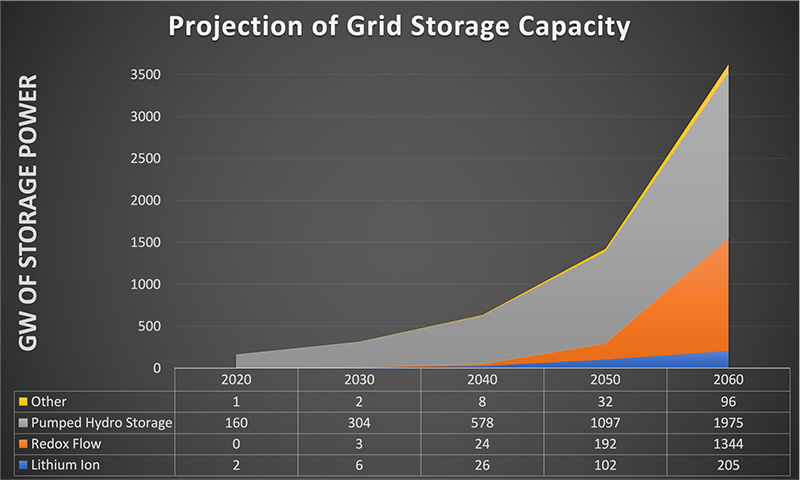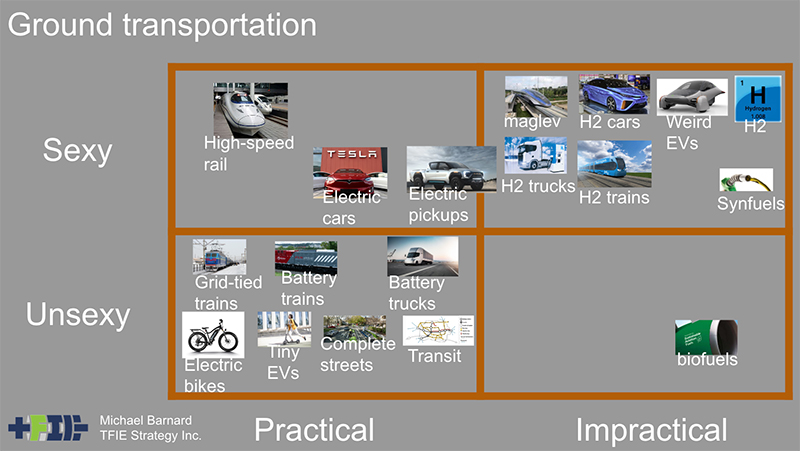|

New US Hydrogen Strategy: Wrong
Department, Wrong Authors

The US
hydrogen strategy was positioned in the wrong federal department. It
was put in the hands of people who deal with fossil fuels all day long
and have a paradigm of burning them for energy, not a paradigm of
electricity for energy. It fails Rumeltís test for the first thing
that makes a good strategy, and so its principles and actions will be
failures as well.
The US Department of Energy (DOE) is in
an interesting spot in the transformation to a low-carbon economy. 55%
of its budget is for nuclear energy, but most of the USAís 100 or so
reactors are aging out and all but a couple will be off the grid by
2035. There certainly arenít any plans to build 100 new nuclear
reactors in the States as the country doesnít have the conditions for
successful nuclear rollout any more, and the current hope of
SMRs will probably fail to deliver.
While over half of the DOE budget is
focused on nuclear, the USA is realistically going to replace the vast
majority of nuclear generation with renewables, additional
transmission ó especially
HVDC ó and storage, just like almost every other country in the
world. All of those technologies are in the DOEís remit as well. So
far so good, although the bureaucracy and internal fiefdoms will
undoubtedly be slow to accept this.
But the DOE also deals with fossil fuels as a minority of its
portfolio. It has a large portion of its budget and staff who deal
with coal, oil, and gas. This is likely where part of the problem lies
with its
recently released draft hydrogen strategy.
Given that Bidenís Inflation Reduction
Act (IRA) has already had a negative impact on European additionality
rules for green hydrogen electrolysis on that continent, itís
interesting that the strategy for hydrogen still has wet ink. The
American model is subsidies for manufacturing green hydrogen to bring
its price down closer to black and gray hydrogen, and that money
talked, with major European players making it clear that they would
decamp to the USA. So, grid electricity for hydrogen in Europe, no
requirement to set up PPAs for sufficient wind and solar to cover the
demand. Pity.
So letís talk about what a good strategy
is. Iíve read the vast majority of strategy books out there ó
occupational hazard for a strategist ó and certainly all the
frequently cited ones or the ones considered important, with the
exception of Clausewitzí
On War. There are really only two good broad books on
strategy, Sun Tzu for military matters and for non-military concerns
Rumeltís
But this assessment is distinctly in the
non-military strategy camp, and so Iíll use Rumeltís kernel of good
strategies to frame my thoughts on the DOE hydrogen strategy.
ďStrategy is designing a way
to deal with a challenge. A good
strategy, therefore, must identify the challenge to be overcome, and
design a way to overcome it. To do that, the kernel of a good strategy
contains three elements: a diagnosis, a guiding policy, and coherent
action.Ē
The diagnosis is the key thing here. What
is going on must be clearly understood. Empirical reality is critical
to good strategy.
This is my projection of hydrogen demand
through 2100, iterated a few times. I use it to assist major
institutional investors, VCs and renewable deployment organizations to
get their strategy for the coming decade of investments, resourcing
and action plans into the right place.
Whatís the most obvious thing about this
projection? Hydrogen demand is shrinking, not growing for much of the
coming decades. Why? Because hydrogen isnít a decarbonization
solution, itís a global warming problem.
Black and gray hydrogen is a CO2e problem
in the range of all of global aviation. Job one is to stop digging
holes, and hydrogen manufacturing today is a big shovel. Itís all from
fossil fuels today, with CO2e emissions from upstream natural and coal
bed methane leakages and CO2 from steam reformation or coal
gasification from 12 to over 35 times the mass of CO2e as hydrogen
manufactured.
And the largest chunk of it is used in
fossil fuel refining, oil refineries to be specific, where itís used
mostly to desulphurize heavy crude like Albertaís product and also for
hydrotreating which is used to stabilize desirable aromatics, a much
smaller volume but high value market. Thatís about 50 million of the
120 million tons of pure and syngas blended hydrogen we consume today,
or 42%. The second largest chunk is for ammonia-based fertilizers,
about 33 million tons, or around 28%. Refinery use has to mostly go
away if we want to deal seriously with global warming. Ammonia-based
fertilizer use has to diminish radically as well, through the four
trends or strategies of shifting subsistence farmers to urban
employment, precision agriculture, low-tillage agriculture, and
agrigenetics solutions such as
Pivot Bioís enhanced nitrogen fixing microbes.
Hydrogen is not used for energy today. It
is used in industrial processes to refine energy carriers, and itís
used in industrial processes to manufacture fertilizer. The other uses
include hydrogenation of vegetable oil for edible oil products and a
bunch of other things.
But itís not a carrier of energy right
now. Which begs the question:
Why is the
US Department of Energy
being tasked with drafting the hydrogen strategy?
The placement of responsibility
presupposes the answer, that hydrogen will be used in the future as a
carrier of energy. And thereís little reason to believe that is true.
This makes the DOE a questionable place
to position a hydrogen strategy. By definition, they canít help but
view it as an energy carrier. Itís their entire paradigm.
It makes more sense to position green
hydrogen as an industrial strategy, something touted by the Biden
Administration as being core to what they are trying to achieve with
their
five-pillar industrial policy. Those pillars are supply chain
resilience, targeted public investment, public procurement, climate
resilience, and equity. Itís not bad, with a more balanced perspective
on China than most US governmental material these days.
Putting hydrogen into the DOE was the
wrong choice. The strategy probably should have been in the hands of
the Department of Commerce (DOC), not the Department of Energy, and
the DOC should have asked for input from the DOE and Department of
Transportation (DOT) where appropriate. That ship has sailed, however,
and likely for the usual reasons when it comes to hydrogen, lobbying
from the fossil fuel industry and starting from the wrong paradigm.
And so, thereís some good stuff in the
draft and a lot of stuff thatís just off base, a bunch of which will
seriously muddle success with decarbonizing hydrogen.
The DOE authors get some of this right.
The first couple of things that they suggest in the demand section,
ďStrategy 1: Target Strategic, High-Impact Uses of Hydrogen,Ē make
perfect sense. We use a lot of methanol and ammonia in
industry and agriculture, itís all made with black or gray
hydrogen today, and we need to replace that with green hydrogen. And
they point out the potential for the use of hydrogen in steel
making to reduce iron ore instead of coal (without
recognizing the efforts around using electricity directly for that
purpose),
But then they fall off the rails rapidly.
First, they make the common mistake that only burning gases or
liquids can provide high quality heat over 300į Celsius. This
is an odd mistake when the USA has made 70% of its steel from scrap in
electric steel minimills for a couple of decades, and those use
electric arc furnaces that provide 1,500-3,000į Celsius high-quality
heat. Similarly, electrically-powered aluminum smelters run at 800į
Celsius. Presumably people in the DOC know this, but the people in the
DOE writing the strategy are oil, gas, and coal heads who assume that
you have to burn gases or liquids for high-quality heat. This just
isnít true, and itís a major failing in the diagnosis section of the
kernel.
You canít get strategy right if you donít
start with reality.

Sexy / Unsexy,
Practical / Impractical quadrant chart for residential, commercial and
industrial heat sources by Michael Barnard, Chief Strategist, TFIE
Strategy Inc.
Heat is important across the economy, but
industrial heat will virtually always be better supplied by
electrically powered solutions in the future. There are a couple
of industrial processes such as cement clinker kilns where I
understand thereís a specific value in jets of flame, but those are
the exception, not the rule. An industrial policy from the DOC would
more likely start with the need for heat, and not start with the false
assumption of a requirement for a liquid or gaseous fuel.
As chemical process engineer Paul Martin,
who has been designing modular chemical processing plans for clients
globally for three decades, has told me on a
couple of occasions, everything he does uses electricity up until
the point that cost-benefit analyses show that fossil fuels are
cheaper when the atmosphere is allowed to be used as an open sewer.

Projection of
grid storage capacity through 2060 by major categories by Michael
Barnard, Chief Strategist, TFIE Strategy Inc.
Then thereís hydrogen for
long-duration storage. One of the head-scratchers in my
discussion with Jigar Shah, the DOEís director of its Loans
Program Office, was the $504 million loan for a hydrogen salt cavern
storage and electricity generation facility on the site of an old coal
plant in Utah. The assertion was that it reused the transmission to
LA, so it was good. But they are putting gas generation on the site to
replace the coal, that will require a bunch of new gas pipeline to
supply the gas, there is no feeder transmission to the site to bring
renewables to it to manufacture green hydrogen, and green hydrogen is
deeply inefficient round trip. Itís what got approved as Utah didnít
want the coal town to disappear, but keeping a rural town with a
couple of thousand people alive after its primary economic purpose is
gone isnít a strategically sound energy or decarbonization solution.
Like every other major country in the
world, the USA has a lot of grid storage today in the form of pumped
hydro. That technology is by far the biggest form of grid storage in
the world, itís by far the largest form of grid storage under
construction, and single pumped hydro facilities commissioned in 2022
dwarf all battery storage on the grid globally. Itís the appropriate
scale and technology for grid storage. Hydrogen is just a bad
technology by comparison for this purpose.

Then thereís
hydrogen and synthetic fuels for trucks and buses, also
touted in the DOE strategy. This in a world where there are 500,000
battery-electric buses on the roads of China, where there are roughly
the same number of battery electric trucks, where new battery-electric
semis are being delivered from multiple manufacturers today, and where
every hydrogen bus and truck test program has proven that they are not
economic compared to battery-electric, with potential en route grid
ties or inductive charging in places.

You have to be looking at
the world through diesel-powered glasses to assume that burning gases
or liquids in trucks and buses is an appropriate choice in a strategy
when battery-electric is an option. Synthetic fuels are much higher
CO2e and much higher cost. Itís mostly just economics, and fuel costs
are about 21% of the costs of trucking. I assessed this end-to-end in
2018 and 2019 in looking at
Carbon Engineeringís direct-air capture air-to-fuel plans, and the
economics and technology have not budged since then.

Sexy/unsexy, practical/impractical
quadrant chart of marine transportation decarbonization by Michael
Barnard, Chief Strategist, TFIE Strategy Inc.
Thereís a different story in
marine transportation, another target for hydrogen in the DOE strategy.
Perhaps if the strategy originated in the Department of
Transportation, which is responsible for marine shipping, there would
be some reasonable material here. However, there are many, such as
Maersk, who are trying to square the circle of synthetic fuels
manufactured from green hydrogen, so perhaps not.
There are a few key points itís possible
that the DOE authors donít know. The first is that 40% of all
deepwater shipping is for bulk oil, gas, and coal shipments between
continents. Thatís all going away. Next is that 15% of all deepwater
shipping is for raw iron ore, heading to the same ports as a lot of
the coal to manufacture steel. Thatís going to be significantly
reduced. Other bulk goods such as grains are already containerizing.
The target is container shipping and itís smaller, in other words.
Next, the question as always is how much
of shipping can electrify. The answer is that all inland shipping and
about two-thirds of near shore shipping can run on batteries, either
permanently installed in the boats and charged as
Corvus Energy has been doing for over a decade, or by putting the
batteries in standard shipping containers (TEU) and swapping them out
in ports, a solution also suitable for trains which Iíll be coming to.
TEUs with batteries installed are already being delivered globally for
grid storage by Tesla and Wšrtsilš, as I discussed with the latter
companyís
global VP for energy storage and optimization, Andy Tang, a few
months ago.

Marine shipping megatonnes fossil
fuels before refueling, chart by Michael Barnard, Chief Strategist,
TFIE Strategy Inc.
That only leaves the
declining deepwater shipping segment that requires a solution, and it
is deeply unlikely to be hydrogen or synthetic fuels. In my assessment
of alternative fuels for marine shipping, I settled on biofuels as the
highest probability for the dominant solution. My projection of marine
energy requirements for that space through 2100 makes it clear that
global carrying capacity of stalk cellulosic biofuels is more than
enough for the actually hard to refuel long haul segments of both
aviation and shipping.

Projection of aviation fuel demand
by type through 2100 by Michael Barnard, Chief Strategist, TFIE
Strategy Inc.
And so, to aviation,
another area the DOE thinks is a target for green hydrogen demand.
From the same Carbon Engineering assessment cited above, and in my
assessments of refueling options for that segment of transportation,
itís clear that hydrogen is not fit for purpose directly, and
synthetic fuels will be much more expensive than SAF biofuels.

Table from Carbon Engineering
synthetic fuel case study by Michael Barnard, Chief Strategist, TFIE
Strategy Inc.
What cannot be electrified with
ever-improving batteries will use SAF biofuels. Theyíve been around
since 2011, most aerospace OEMs are certifying their aircraft on them,
and they are flying blended or solely SAF biofuels in test routes with
real cargo and passengers today. But as the table shows, as long as
Jet A-1 and the like are cheaper, thatís what aviation will use.
Thankfully thatís changing in multiple parts of the world as the
weird untaxed condition of jet fuels ends, something I explored a
few months ago.
And then thereís rail, another
target the DOE strategy considers to be high value. China has
built
25,000 miles of high-speed, grid-tied, electrified freight and
passenger rail in the past 15 years, reaching 93% of domestic
cities, and itís connecting neighboring countries into the network.
Germany just announced that it will not build any more hydrogen rail
after the 50-mile test route, as economic studies show itís 3 times as
expensive as grid-tied/battery hybrid, and almost that much more
expensive than just battery-electric. All freight train engines in the
USA are already diesel-electric hybrid, and grid-tying them with
overhead lines is a common practice globally.
Once again, those battery-filled TEUs are
perfect components for a battery-electric train system, rechargeable
at existing transshipment points, where the
cranes are going all electric as well. Having had CN Rail as a
client a decade ago, looked at global container shipping, and looked
at container port management software, itís relatively trivial to have
TEUs filled with batteries charging in container transshipment
facilities and dropped onto waiting train cars or into the holds of
container vessels.
Finally, the strategy references
residential and commercial heating as a target for hydrogen.
Iíve explored this (see the heating quadrant chart above), as have
dozens of others, and hydrogen would be both
vastly more expensive than natural gas heating and
much less safe. When air, ground, and water-sourced
heat pumps are already refueling very large commercial and
residential buildings, running with coefficients of performance of 3
to 5, being built in gigafactories in Texas, and no hydrogen furnaces
or stoves for residential or commercial use are available for purchase
or certified for use, you really have to want to burn something to
consider hydrogen as an alternative.
I might return to this to address the
wrong-headed assumptions regarding the need to transport hydrogen by
pipeline, rail and ship, another set of paradigm errors the DOE
strategy makes. Suffice it to say that virtually all hydrogen is
manufactured at point of demand today because itís so difficult and
expensive to transport, and that its low energy density by volume and
tiny molecular size means that itís very expensive to transport more
than a few hundred meters. Iíve assessed
pipeline and
shipping costs for hydrogen, and they make no sense compared to
putting renewable electricity into HVDC lines, a common technology
globally, with a third undersea HVDC interconnector going in in the
UK, tens of thousands of kilometers of HVDC in China, Morocco to UK
HVDC under construction, and Australia to Singapore HVDC proposed.
The future of energy transmission is
electricity flowing down high voltage direct and alternating current
lines, not moving molecules.
The reason that the DOE strategy, if it
persists in this form, will be so problematic for the USA is that it
first diffuses the attention of hydrogen as a decarbonization problem,
so it wonít be addressed promptly. Second, itís going to cause a lot
of organizations to waste a lot of time and money building
infrastructure to manufacture hydrogen in locations where there will
be no demand. In some cases, the hydrogen will be able to be
repurposed for high-value uses such as ammonia-based fertilizers. But
in a lot of cases, it will simply be an expensive white elephant and
moved at great expense to someplace more useful.
So why is the USA making this obviously
poor choice? Why is hydrogen positioned in the DOE as opposed to the
DOC? Why are all of these clearly dead-end use cases considered to be
ďStrategic, High-Impact Uses of Hydrogen,Ē as the DOE strategy
asserts?
Well, the fossil fuel industry and
governments with large tax and royalty revenues are lobbying hard to
make hydrogen a Ďreplacementí for fossil fuels. They know that unless
hydrogen does the heavy lifting, their fossil fuel reserves have zero
economic value. As
Michael Liebreich likes to point out, the fossil fuel industry
canít lose by pushing hydrogen. Theyíll either delay real climate
action, or theyíll get a lot of governmental money to make blue
hydrogen out of their fossil fuel reserves.
Oh, did I mention the US DOE hydrogen
strategy is also all over manufacturing hydrogen from fossil fuels
with carbon capture and storage bolted on? Are you surprised?
The US hydrogen strategy was positioned
in the wrong federal department due to the wrong framing. It was put
in the hands of people who deal with fossil fuels all day long and
have a paradigm of burning them for energy, not a paradigm of
electricity for energy. It fails Rumeltís test for the first thing
that makes a good strategy, acceptance of empirical reality, and so
its principles and actions will be failures as well.
The USA should go back to the drawing
board, and quickly. Iíd be happy to assist them.
Green Play Ammoniaô, Yielderģ NFuel Energy.
Spokane, Washington. 99212
www.exactrix.com
509 995 1879 cell, Pacific.
exactrix@exactrix.com
|